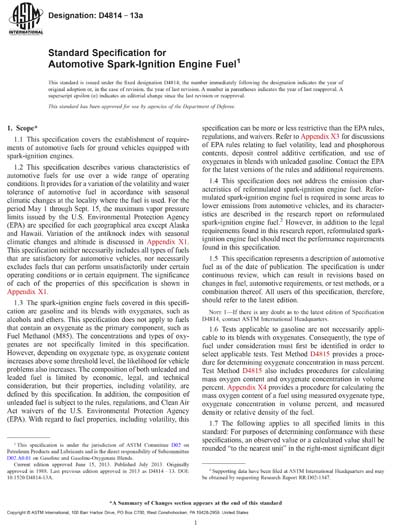Historical
ASTM D4814-13a
Standard Specification for Automotive Spark-Ignition Engine Fuel
1.1 This specification covers the establishment of requirements of automotive fuels for ground vehicles equipped with spark-ignition engines.
1.2 This specification describes various characteristics of automotive fuels for use over a wide range of operating conditions. It provides for a variation of the volatility and water tolerance of automotive fuel in accordance with seasonal climatic changes at the locality where the fuel is used. For the period May 1 through Sept. 15, the maximum vapor pressure limits issued by the U.S. Environmental Protection Agency (EPA) are specified for each geographical area except Alaska and Hawaii. Variation of the antiknock index with seasonal climatic changes and altitude is discussed in Appendix X1. This specification neither necessarily includes all types of fuels that are satisfactory for automotive vehicles, nor necessarily excludes fuels that can perform unsatisfactorily under certain operating conditions or in certain equipment. The significance of each of the properties of this specification is shown in Appendix X1.
1.3 The spark-ignition engine fuels covered in this specification are gasoline and its blends with oxygenates, such as alcohols and ethers. This specification does not apply to fuels that contain an oxygenate as the primary component, such as Fuel Methanol (M85). The concentrations and types of oxygenates are not specifically limited in this specification. However, depending on oxygenate type, as oxygenate content increases above some threshold level, the likelihood for vehicle problems also increases. The composition of both unleaded and leaded fuel is limited by economic, legal, and technical consideration, but their properties, including volatility, are defined by this specification. In addition, the composition of unleaded fuel is subject to the rules, regulations, and Clean Air Act waivers of the U.S. Environmental Protection Agency (EPA). With regard to fuel properties, including volatility, this specification can be more or less restrictive than the EPA rules, regulations, and waivers. Refer to Appendix X3 for discussions of EPA rules relating to fuel volatility, lead and phosphorous contents, deposit control additive certification, and use of oxygenates in blends with unleaded gasoline. Contact the EPA for the latest versions of the rules and additional requirements.
1.4 This specification does not address the emission characteristics of reformulated spark-ignition engine fuel. Reformulated spark-ignition engine fuel is required in some areas to lower emissions from automotive vehicles, and its characteristics are described in the research report on reformulated spark-ignition engine fuel.2 However, in addition to the legal requirements found in this research report, reformulated spark-ignition engine fuel should meet the performance requirements found in this specification.
1.5 This specification represents a description of automotive fuel as of the date of publication. The specification is under continuous review, which can result in revisions based on changes in fuel, automotive requirements, or test methods, or a combination thereof. All users of this specification, therefore, should refer to the latest edition.
1.6 Tests applicable to gasoline are not necessarily applicable to its blends with oxygenates. Consequently, the type of fuel under consideration must first be identified in order to select applicable tests. Test Method D4815 provides a procedure for determining oxygenate concentration in mass percent. Test Method D4815 also includes procedures for calculating mass oxygen content and oxygenate concentration in volume percent. Appendix X4 provides a procedure for calculating the mass oxygen content of a fuel using measured oxygenate type, oxygenate concentration in volume percent, and measured density or relative density of the fuel.
Content Provider
ASTM International [astm]






